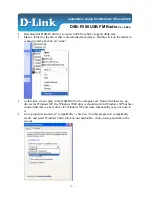
34
35
Child unit (star motif)
Hold down button while turning on device. (Hold down both outer buttons in parallel).
Press
/
buttons and select
bA
. The child symbol
will be displayed. In order to save
the settings, briefly press the
PTT
button.
Parental unit (without motif)
Hold down button while turning on device. (Hold down both outer buttons in parallel).
Press
/
buttons and select
PA
. The parental symbol
will be displayed. In order to
save the settings, briefly press the
PTT
button.
Now the channel (01 to 18) is displayed, which, on the child unit, is supplemented by the
letter
b
, or on the parent unit, by the letter
P
. Then, the corrsponding symbols
or
will be displayed.
Using several child units
With the help of several child units, you can monitor multiple children, event. multiple
rooms. For this, all devices must be set to the same channel. When using in this way, we
recommend deactivating reach control, as due to variouse devices, false alarms may occur.
Keep in mind that in the parental unit, you can hear only one child at a given time. Besides
this, you should lower the volume on child units to 0, as otherwise, the children could mu-
tually listen to each other or disturb each other.
Chapter 2: Use in „walkie talkie“ operating moden
Both devices are factory-set to the „baby monitor operating mode. If you wish to re-set the
devices to the operating mode „radio device PMR446“, execute the following steps.
Hold down the button while turning on the device (hold down the OFF/ON button for
several seconds). By pressing the
/
button, select
ro
. In order to save the settings,
briefly press the
PTT
button.
Selection of PMR446 channel
This broadcasting/receiving system has 8 PMR446 channels available. On top of this, you
can select individual PMR446 coding for each channel individually through CTCSS tones (38
possible codes). The code will appear to the right of the number of the channel as a small
two-digit number between 01 and 38 or
oF
.
Make sure that all devices are set to the same channel and CTCSS tone.
Press button
1×
and then choose the required PMR446 channel with the help of
/
buttons.
Setting CTCSS or DCS code
Additional CTCSS or DCS codes serve to prevent listening in on other conversations on the
same channel. This does not mean, however, that the transmission is protected against in-
terception. There is always the possibility that unencrypted analog radio signals will be inter-
cepted. CTCSS (Continuous Tone Coded Squelch Signal) or DCS (Digital Coded Squelch) tones
are tones beyond the low frequency audibility threshold, which are transmitted together
with the microphone signal. In case of reception, the device will check whether a CTCSS or
DCS tone is transmitted and will turn on the speaker only when the correct code is received.
Setting the CTCSS code:
Press button
once
. 01–38 or
oF
flashes on the display. For setting the required code, press
/
buttons. In order to save the settings, briefly press the
PTT
button.
Setting the DCS code:
Press the button
2×
. 01–38 or
oF
flashes on the display. For setting the required code,
press
/
buttons. In order to save the settings, briefly press the
PTT
button.
Warning:
it is possible to activate only
CTCSS
or
DCS.
Transmission
To broadcast, press and hold down
PTT
button. To receive, let go the button again.
Searching for channels
This function will search all PMR446 channels according to signal. To start search, hold down
button for a long time. The search is interrupted as soon as the signal is captured. You
can then listen to the channel for a period of 8 seconds, until the search continues. After
ending the search, hold down
button for a long time once again.
Warning:
searching channels is availavle only in the „PMR446“ operating mode.
Ringtone selection
Press button
9×
.C will appear on the display, as well as current settings, which will flash.
To select ringtone from possibilities 01-03 or
oF
, press
/
buttons. In order to save the
settings, briefly press the
PTT
button.
















































